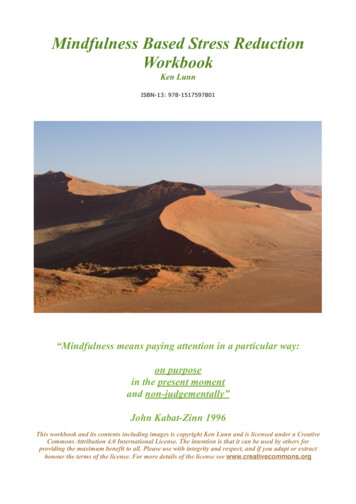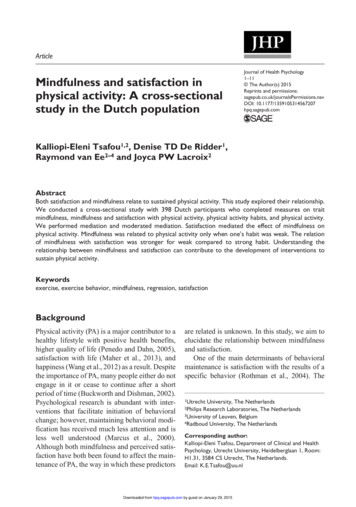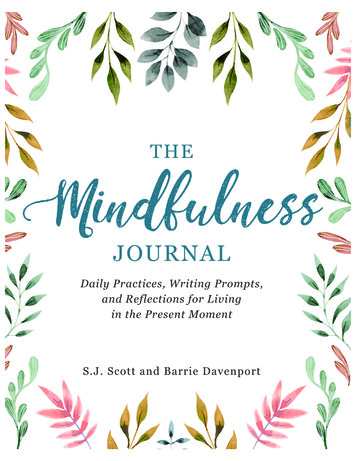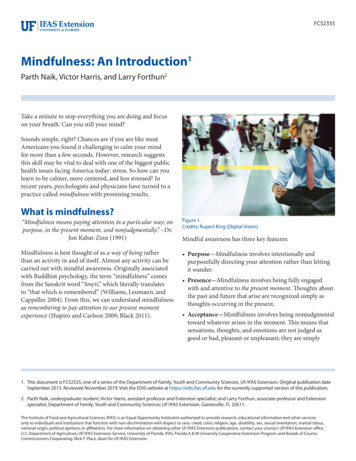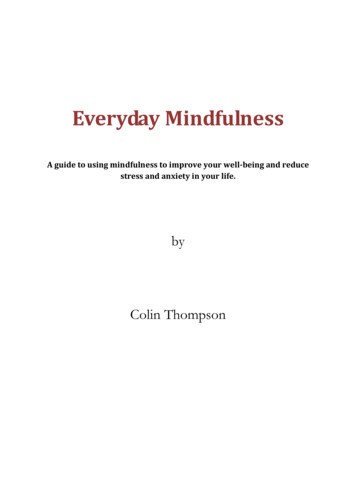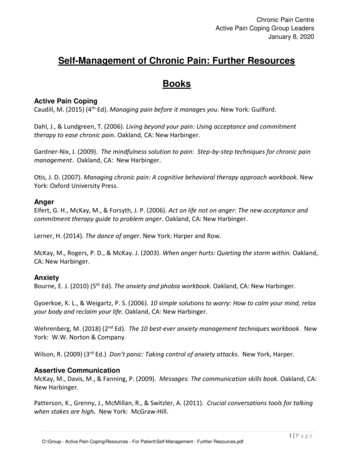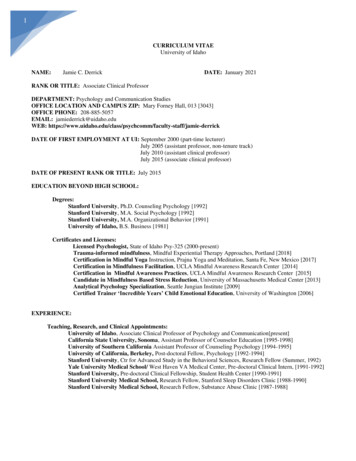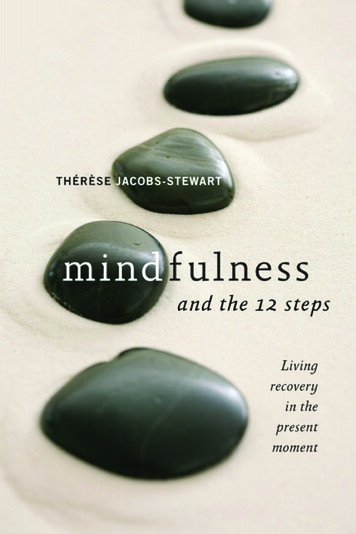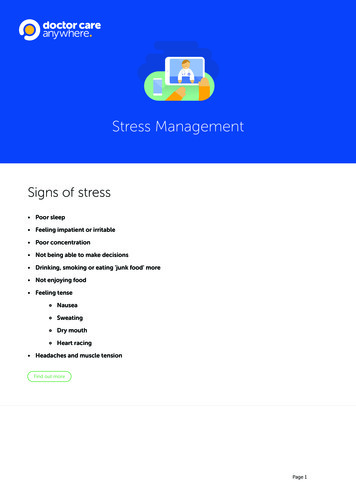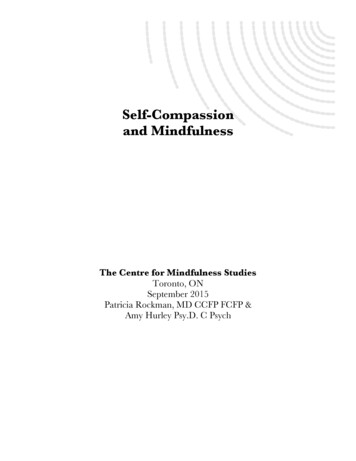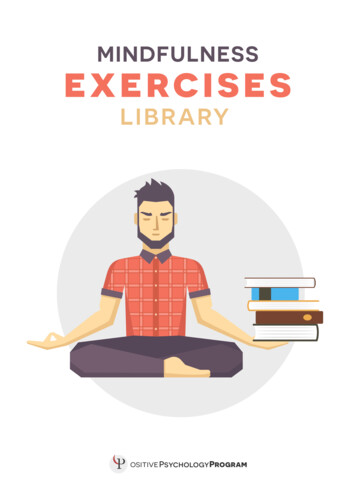
Transcription
Table ofContentschapter one: mindfulness exercisesfor adults24 Mindfulness Activities for Group Therapy36 Mindfulness Interventions for Adults9Introducing Dialectical Behavioral Therapy (DBT)155 Mindfulness Exercises from DialecticalBehavioural Therapy17Mindfulness Techniques for Depression, Anger, Addiction,and Anxiety19chapter two: mindfulness activitiesfor children284 Mindfulness Activities for Children3015 Tips for Teaching Mindfulness to Kids328 Mindfulness Games, YouTube Videos, and Apps toSupport Your Teachings333 Mindfulness Training Classes For Childrenwith Anxiety36The Basics: Teaching Essential Mindfulness Practices37Mindfulness Meditation for Very Young Children38The Benefits Of Mindfulness In Schools39references41
Ichapter oneMindfulness Exercises For Adults
Mindfulness ExercisesFor AdultsPeople who meditate are happier, healthier, and moresuccessful than those who don’t. Those amazingbenefits of practicing meditation and mindfulnessmake you want to try it yourself.Good chance you have already tried meditation ormindfulness before. Maybe you decided – after a fewfrustrating attempts – that you must be one of thosepeople with an errant mind that just won’t followinstructions.This is a limiting belief. Like any skill, mindfulness takes practice. Try it again!Now don’t roll your eyes. Sometimes the only thing standing between our goalsand us is a little bit of direction. Hopefully, this chapter can provide the directionyou need to give mindfulness a try in your own life or in your therapy or coachingsessions. Let’s dive in!4 mindfulness activities for grouptherapyIn many cases, group therapy that incorporates mindfulness has shown somepromising results. It has proven to be as effective as cognitive behavioral therapy(CBT), a staple of the clinical psychology world (Kocovski, Fleming, Hawley,Huta, & Antony, 2013).There is also evidence to show that group mindfulness therapy is also as effectiveas individual CBT (Sundquist et al., 2015). In a global climate with relatively fewclinical psychologists in relation to the demand, and in which individual therapytime is limited and expensive, the proven efficacy of group-based therapy isreally good news.MINDFULNESS EXERCISES LI B RAR Y 3
Even if you’re not currently attending therapy or feel no need to visit a therapist,or are a therapist looking to expand your skills, there are mindfulness-focusedgroups that attempt to share and deepen meditation practice without an addedtherapeutic focus of stress, anxiety, or other mental health problems (Brach,2016).FLEMING & KOCOVSKI’S TREATMENT PLANOne such group mindfulness-based treatment program by Fleming & Kocovski(2007) aimed to reduce social anxiety. It is a good example of how mindfulnessexercises can be incorporated into a group setting for its various benefits.In this example, the exercises used have proven effective for treating socialanxiety disorder in particular; however, they can be applied to many other groupsettings with positive results.The treatment plan involves groups of about 8 members meeting for 2 hours,every week for 12 weeks. The first portion of each session is devoted to a shortmindfulness exercise and discussion. The treatment plan’s mindfulness exercises went as follows:bodyscanThe Body Scan, as thename suggests, entailsbringing awareness toeach part of the body. Session 1: Raisin Exercise Session 2: Body Scan Session 3: Mindful Seeing Session 4: Mindfulness of the breath, sounds and thoughts Session 5: Acceptance of thoughts and feelings exercise Session 6: Acceptance of Social Anxiety Session 7: Mountain Meditation Session 8: Acceptance of Social Anxiety Session 9: Breath Focus without Guidance Session 10: Lake Meditation Session 11: Non guided Breath FocusThere are many different mindfulness exercises mentioned here which werespecifically put together for the aim of reducing social anxiety disorder; however,the first three exercises are commonly used in group sessions to encouragemindfulness. A description of each of these three group exercises can be foundbelow:MINDFULNESS EXERCISES LIBRARY 4
1. THE RAISIN EXERCISEThis is a great introductory exercise for beginners to start practicing mindfulness,since it can be attempted by anyone with any kind of food (although one with aninteresting or unusual texture, smell, or taste is best).In this exercise, the facilitator provides participants with a few raisins and asksthat they pretend they have never seen a raisin before.The facilitator then asks that the group pay careful attention to: The way the raisin looks How it feels How their skin responds to its manipulation Its smell Its tasteFocusing on the single object of the raisin is meant to bring the participant’s mindto the present, to what is right in front of them.By focusing on the raisin in their hand and making apoint to notice everything about it, they are unlikely tobe expending energy, time and attention on worryingor ruminating about other parts of their livesIt is nearly impossible to avoid practicing mindfulness when you follow theseinstructions and take notice of what is in front of you in the present moment.2. THE BODY SCANAnother popular exercise for practitioners of mindfulness is called the Body Scan.It requires very little in the way of props or tools, and it is also easily accessible formost beginners.Would you like to follow a Body Scan right now? Try this 30 minute guidednarrative by expert and founder of Mindfulness Based Stress Reduction JonKabat Zinn: Step 1: the Body Scan begins with the participants lying on their backsMINDFULNESS EXERCISES LI B RAR Y 5
with their palms facing up and their feet falling slightly apart.This exercisecan also be done sitting on a chair with feet resting on the floor. Step 2: the facilitator then asks the participants to lie very still for theduration of the exercise, and move with awareness if it becomesnecessary to adjust their position. Step 3: next, the facilitator begins guiding the Body Scan. Participantsbegin by bringing awareness to the breath, noticing the rhythm, theexperience of breathing in and expelling out. The facilitator explains thatnobody should try to change the way they are breathing but rather justhold gentle awareness on the breath. Step 4: next, the facilitator guides attention to the body: how it feels, thetexture of clothing against the skin, the contours of the surface on whichthe body is resting, the temperature of the body and the environment. Step 5: the facilitator guides awareness to the parts of the body that aretingling, sore, or feeling particularly heavy or light, s/he asks the participantsto note any areas of their body where they don’t feel any sensations at allor are hypersensitive. A typical Body Scan runs through each part of thebody, paying special attention to the way each area feels, the scan usuallymoves as follows: From toes of both feet to the rest of the feet (top, bottom, ankle) then to the Lower legs Knees Thighs and Pelvic region- buttocks, tailbone, pelvic bone, genitals. From there moving toMINDFULNESS EXERCISES LIBRARY 6
The Abdomen, then the Chest Lower back Upper back- back ribs & shoulder blades Hands (fingers, palms, backs, wrists) Arms (lower, elbows, upper) Necklace Head (jaw, mouth, mouth, nose, cheeks, ears, eyes, foreheead, top) and finally ending with the blow hole (Fleming & Kocovski, 2007)After the Body Scan is complete and the participants feel ready to come back tothe room they can slowly open their eyes and move naturally to a comfortablesitting position.Now that you have a firmer understanding of the Body Scan, check out this freePDF mindful body scan script which will help you facilitate this exercise for otherswithin a group setting.3. MINDFUL SEEINGFor some, the absence of visual stimuli can feel stifling. After all, a healthyimagination does not come naturally to everyone. The activity of Mindful Seeingmay be helpful to anyone who identifies with this feeling.This is a simple exercise, requiring only a window with some kind of a view.The facilitator guides the group following these steps: Step 1: find a space at a window where there are sights to be seenoutside. Step 2: look at everything there is to see. Avoid labeling and categorizingwhat you see outside the window; instead of thinking “bird” or “stopsign”, try to notice the colors, the patterns, or the textures. Step 3: pay attention to the movement of the grass or leaves in thebreeze, notice the many different shapes present in this small segment ofthe world you can see. Try to see the world outside the window from theperspective of someone unfamiliar with these sights. Step 4: be observant, but not critical. Be aware, but not fixated.MINDFULNESS EXERCISES LI B RAR Y 7
Step 5: if you become distracted, gently pull your mind away from thosethoughts and notice a color or shape again to put you back in the rightframe of mind.This exercise only lasts a few minutes, but can open upa world of discovery in an otherwise familiar placeThis extensive group treatment plan of Fleming and Kocovski’s 2007 work offersa glimpse of how to use mindfulness in any kind of group session and providesdetailed worksheets, exercises, and handouts which can provide inspiration andguidance for your group facilitation.4. MINDFUL LISTENINGThis last activity is extracted from the Positive Psychology Toolkit and introducesmindful listening as a group exercise.Mindful listening is an important skill and can be a great group mindfulnessexercise. In general, people thrive when they feel fully “heard” and “seen.” Inother words, mindful listening involves a form of self-regulation in which thefocus on the self is set aside. Mindful listening can create an inner stillness inboth parties as the speaker may feel free of the listener’s preconceptions andprejudices, and the listener is free of inner chatter whilst learning valuable positivecommunication skills.The Mindful Listening exercise involves these steps: Step 1: invite each participant to think of one thing they are stressedabout and one thing they look forward to. Step 2: once everyone is finished each participant takes their turn insharing their story with the group, Step 3: encourage each participant to direct attention to how it feels tospeak, how it feels to talk about something stressful as well as how it feelto share something positive. Step 4: participants are instructed to observe their own thoughts, feelingsand body sensations both when talking and listening. Step 5: after each participant has shared, you can break into small groupsand answer the questions stated bellow. Next, you regroup into thegroup and have a discussion and debrief with these questions.MINDFULNESS EXERCISES LIBRARY 8
Those questions are: How did you feel when speaking during the exercise? How did you feel when listening during the exercise? Did you notice any mind-wandering? If so, what was the distraction? What helped you to bring your attention back to the present? Did your mind judge while listening to others? If so, how did “judging” feel in the body? Were there times where you felt empathy? If so, how did this feel in the body? How did your body feel right before speaking? How did your body feel right after speaking? What are you feeling right now? What would happen if you practiced mindful listening with each person thatyou spoke with?Do you think mindful listening would change the way you interact and relate withothers? How would it feel if you set the intention to pay attention with curiosity,kindness, and acceptance to everything you said and everything you listenedto?In addition to the group activities mentioned, you may also be interested in tryinggentle yoga or qigong, both of which involve deliberate posture, purposefulbreath, and an emphasis on awareness. Both of these activities have providedevidence for the benefits of mindfulness (Newsome, Waldo, & Gruszka, 2012).6 mindfulness interventions for adultsThere are several ways to engage in mindfulness on an individual level, includingworksheets, techniques, and different exercises.If the idea of participating in group mindfulness exercises is anxiety-provoking orstressful for yourself or your clients then diving into mindfulness practice alonecan be the best way to proceed. Here are 6 exercises which can help to buildmindfulness in different ways:MINDFULNESS EXERCISES LI B RAR Y 9
1. THE SELF-COMPASSION PAUSEself-compassionTreating ourselves withkindness when we are inpain or distressed.This free PDF worksheet on The Self-Compassion Pause guides the readerthrough an exercise on practicing mindfulness and self-compassion. It is anideal worksheet for many who struggle to show themselves compassion, eventhough they may be quick to extend compassion to others. It is also a great wayto practice mindfulness by bringing awareness to emotions and staying in themoment with them. The worksheet begins with noting the date and whether the focus onawareness is on heart, body, or thoughts on the current day. Next, the worksheet provides a short description on the importance ofself-compassion for maintaining quality of life. The next section provides the method for the exercise. You start withnoticing feelings by taking a moment to pause thoughts and actions, witha focused awareness that being mindful can help. Next, the worksheet instructs you to move a hand over the heart, giveyourself a hug, or make physical contact with yourself in some other way,and take a few deep breaths. After this is the important step of acknowledging suffering. This stepis both a place to practice mindfulness and encourages mindfulness asresult. The aim is not to become overwhelmed by the pain or emotionbut rather acknowledge it as real and hurtful, while giving yourselfpermission to feel it.While the last step may be the most difficult, it is also a very important one. Itinvolves vocalizing three statements:1.“This is suffering” (or something similar)2.“Suffering is part of being human” (acknowledge that all humans sufferand struggle)3.A phrase that you feel offers compassion, “May I love and acceptmyself just as I am”2. SELF-INQUIRY MEDITATIONself-inquiryThe constant attention tothe inner-awereness: ‘whoam I?”The Self-Inquiry Meditation is focused on self-inquiry, a technique used inmeditation to gain enlightenment. (download the PDF here)It begins the same way the self-compassion worksheet does, by jotting down thedate and what area is the focus of awareness for the day.MINDFULNESS EXERCISES LIBRARY 10
Next, the worksheet offers a short description of self-inquiry and why it isworthwhile to practice it. Self-inquiry can bring about a sense of peace andopenness to experience, among other desirable outcomes.To begin the exercise, follow these steps:1.Take a comfortable seated position2.Let yourself settle into your body and your mind3.Try to let go of thoughts and clear the mind of its usual considerations4.Focus your attention on the feeling of being you. Who are you? How does itfeel to be you? What is it that makes up your inner self?If you find yourself distracted by an errant thought, bring your awareness back toyourself by asking “To whom is this thought occurring?”This exercise can be continued for as long as desired. It is a difficult exercise as itrequires the individual to focus on the self, which not many find enjoyable. If youare having trouble staying in your own head, try practicing the self-compassionexercise first to make the experience more comfortable.The goal of self-inquiry is to be aware of yourself and to bring awareness tothe source of all that you are. It can be so easy to get lost in everyday tasks anddistractions.Self-inquiry can help bring awareness to the one who isdealing with all these thoughts and feelings – you!3. FIVE SENSES EXERCISEThis exercise is called “five senses”, and provides guidelines on practicingmindfulness quickly in nearly any situation. All that is needed is to noticesomething you are experiencing with each of the five senses.Follow this order to practice the five senses exercise: Notice five things that you can see.Look around you and bring your attention to five things that you can see. Picksomething that you don’t normally notice, like a shadow or a small crack in theconcrete.MINDFULNESS EXERCISES LI B RAR Y 11
Notice four things that you can feel.Bring awareness to four things that you are currently feeling, like the texture ofyour pants, the feeling of the breeze on your skin, or the smooth surface of a tableyou are resting your hands on. Notice three things you can hear.Take a moment to listen, and note three things that you hear in the background.This can be the chirp of a bird, the hum of the refrigerator, or the faint sounds oftraffic from a nearby road. Notice two things you can smell.Bring your awareness to smells that you usually filter out, whether they’re pleasantor unpleasant. Perhaps the breeze is carrying a whiff of pine trees if you’re outside,or the smell of a fast food restaurant across the street. Notice one thing you can taste.Focus on one thing that you can taste right now, in this moment. You can take asip of a drink, chew a piece of gum, eat something, or just notice the current tastein your mouth or open your mouth to search the air for a taste.This is a quick and relatively easy exercise to bring you to a mindful state quickly.If you only have a minute or two or, for whatever reason, you don’t have the timeor tools to try a body scan or fill out a worksheet, the five senses exercise can helpyou or your clients bring awareness to the current moment in a short amount oftime.MINDFULNESS EXERCISES LIBRARY 12
4. THE MINI-MINDFULNESS EXERCISEAnother great exercise to try if you are strapped for time is the mini-mindfulnessexercise. In this lesson, there are only three steps: Step 1: step out of “automatic pilot” to bring awareness to what youdoing, thinking, and sensing in this moment.Try to pause and take a comfortable but dignified posture. Notice the thoughtsthat come up and acknowledge your feelings, but let them pass. Attune yourselfto who you are and your current state. Step 2: bring awareness to the breathing for six breaths or a minute.The goal is to focus attention on one thing: your breath. Be aware of the movementof your body with each breath, of how your chest rises and falls, how your bellypushes in and out, and how your lungs expand and contract. Find the pattern ofyour breath and anchor yourself to the present with this awareness. Step 3: expand awareness outward, first to the body then to theenvironment.Allow the awareness to expand out to your body. Notice the sensations youare experiencing, like tightness, aches, or perhaps a lightness in your face orshoulders. Keep in mind your body as a whole, as a complete vessel for yourinner self.If you wish, you can then expand your awareness even further to the environmentaround you. Bring your attention to what is in front of you. Notice the colors,shapes, patterns, and textures of the objects you can see. Be present in thismoment, in your awareness of your surroundings.When you are ready to finish the exercise, allow youreyes to open slowly and try to carry that mindfulnesswith you as you go about your dayThese four exercises mentioned above are taken fromwww.mindfulnessexercises.com.MINDFULNESS EXERCISES LI B RAR Y 13
5. MINDFUL WALKING DOWN THE STREET TECHNIQUEOne core process, which can be influenced by mindfulness practice, is our abilityto observe out thoughts emotions and sensations without reacting to fix them,hide or solve them. This awareness creates room for choice between impulseand action which can help develop coping skills and positive behavioral change. In the first step of this intervention; the facilitator helps the client visualizea scenario in which they are walking down a familiar street when theylook up and see someone they know on the other side of the street. Theywave however the other person doesn’t respond and continues to walkright past. In the second step of the mindful walking exercise the facilitator promptsreflection from the client by asking a series of questions:1.As you were imagining, did you notice any of your thoughts?2.As you were imagining, did you notice any of your emotions?It can be sometimes be challenging to differentiatebetween thoughts and emotions as they can play offeach other quite rapidly In the third and final step of the exercise, the facilitator asks the client toreflect on the series of emotions and thoughts that came up and howthis affects their behavior, whether the exercise was helpful and for anyfinal comments.6. THE THREE MINUTE BREATHING SPACEUnlike meditations or a Body Scan, this exercise is quick to perform and easy toget started with a mindfulness practice in your busy life or that of your clients.With meditations and the body scan thoughts often pop up and keeping a quietand clear head can be a challenge.This last exercise of Three Minute Breathing Space can be the perfect techniquefor those with busy lives and minds. The exercise is broken into three sections,one per minute, and works as follows:1.The first minute is spent on answering the question, “how am I doingright now?”, while focusing on the feelings, thoughts and sensations thatarise and trying to give these words and phrases.MINDFULNESS EXERCISES LIBRARY 14
2.The second minute is spent on keeping awareness on the breath.3.The last minute is used for an expansion of attention from solely focusingon the breath, feeling the in’s and out’s and how they affect the rest ofthe body.This exercise can be rather challenging for keeping a quiet mind and oftenthoughts can pop up. The idea is not to block them, but rather just let them comeinto your mind and then disappear back out again. Try to just observe them.introducing dialectical behavioraltherapy (dbt)cognitivebehavioral therapyThis is a type ofpsychotherapy that hasbeen used for decades totreat a variety of disorders,from depression andDialectical Behavioral Therapy (or DBT) is a type of cognitive behavioral therapythat focuses on the psychosocial aspects of therapy, emphasizing the importanceof a collaborative relationship, support for the client, and the development of skillsfor dealing with highly emotional situations. It is mainly used to treat individualswith borderline personality disorder. The first priority for DBT treatment is to target the life-threateningbehaviors that often manifest in people with severe mental healthproblems. Second, therapists aim to eliminate the behaviors that interfere withtherapy. These behaviors are anything which become obstaclesbetween the client and successful treatment, such as refusal to strive forthe goals of DBT, missing sessions, etc. Next, DBT therapists aim to correct the behaviors that interfere withthe client’s quality of life, including non-productive relationshipbehaviors, communication problems, and bad financial decisionmaking.Practicing mindfulness helps DBT clients learn to slowthe pace of their thoughts, recognize thoughts for whatthey are, and sharpen their focusThe behavioral skills taught in group and individual therapy fall into one of fourcategories:1.MindfulnessMINDFULNESS EXERCISES LI B RAR Y 15
2.3.4.Distress toleranceInterpersonal effectivenessEmotion regulation (Linehan, 1993)Mindfulness is a core skill taught in DBT, as it helps clients raise awareness oftheir own thoughts and feelings (Jennings & Apsche, 2014).THE EFFECTIVENESS OF DIALECTICAL BEHAVIOURALTHERAPY-MINDFULNESSIn one study, Dialectical Behavioral Therapy-Mindfulness (DBTM) training wasadded to general psychiatric treatment to test its effectiveness. A module onmindfulness was developed to help clients achieve the “wise mind” and focusedon two sets of skills, called the “what” skills and the “how” skills (Soler et al., 2012).What are the “What” skills?This first set of skills is meant to help the client learn how to:1.simply observe their experience,2.describe their experience using verbal labels, and3.be fully present in the moment and in their actions without feeling selfconscious.These skills allow the client to be aware of what is happening to them and oftheir part in their own experience. Becoming aware of their own thoughts andgrounded in the present forms the foundation for the next set of “how” skills.How do the “How” Skills Work?The “how” skills set refers to the goal of teaching clients how to observe, describeand participate in their own experience. This set of skills is intended to help clients:1.learn to have experiences in a non-evaluative, or non-judgmental, manner,2.focus on one thing at a time and learn to bring their attention back to thetarget when they go off course,3.be effective, or keep their focus on their goals regardless of their currentmood (Soler et al., 2012).The clients were also taken through a series of other mindfulness interventionsincluding mindful breathing, the body scan and other simple awarenesspractices.The outcome of this study showed that individuals who received DBTM trainingMINDFULNESS EXERCISES LIBRARY 16
in addition to the usual treatment garnered enhanced benefits compared to thegroup who received only the usual psychiatric treatment. Additionally, it wasfound that the more minutes an individual spent practicing mindfulness, thegreater the improvements in psychiatric symptoms (Soler et al., 2012).DBT clearly has something to teach us all in its application of a wide range ofmindfulness techniques and exercises. The best news being that these exercisescan be applied to other individual clients and groups with their own uniquebenefits. Let’s take a look at a few easily applicable examples.5 mindfulness exercises from dialecticalbehavioural therapyIn addition to the DBT mindfulness techniques used in clinical research, there aremany informalmindfulness techniques and exercises shared online for anyoneto try.One such source comes is DrivingPeace.com, which offers five DBT-basedmindfulness practices that can help with anxiety, especially anxiety resultingfrom borderline personality disorder, however, could be beneficial to a numberof different clients. These five exercises are quick and easy and can be put topractice every day:1. OBSERVE A LEAF FOR FIVE MINUTESThis exercise calls for nothing but a leaf and your attention. Pick up a leaf, hold itin your hand, and give it your full attention for five minutes. Notice the colors, theshape, the texture, and the patterns. This will bring you into the present and alignyour thoughts with your current experience.2. MINDFUL EATING FOR FOUR MINUTESAs with the raisin exercise described above, this exercise calls for mindful eating.MINDFULNESS EXERCISES LI B RAR Y 17
Pay attention to what you are holding (preferably not something messy!), noticethe feeling of it in your hands. Once you have noticed the texture, the weight, thecolor, etc., move on to bringing your awareness to the smell.Finally, move on to eating, but do so slowly and with concentrated attention.Notice the taste and its texture against your tongue. This exercise may help youdiscover new experiences with familiar foods.3. OBSERVE YOUR THOUGHTS FOR FIFTEEN MINUTESThis exercise is a staple of mindfulness, designed to simply enhance yourawareness of your own thoughts.To begin, sit or lie down in a comfortable position and try to let all tension in yourbody dissipate. Focus on your breathing first, then move your awareness to whatit feels like to be in your body, and finally move on to your thoughts.Be aware of what comes into your head, but resist the urge to label or judge thesethoughts. Think of them as a passing cloud in the sky of your mind.If your mind wanders to chase a thought, acknowledge whatever it was that tookyour attention and gently guide your attention back to your thoughts.4. MINDFULNESS BELL EXERCISE FOR FIVE MINUTESIn this exercise, you begin by closing your eyes and listening for the cue. Whenyou hear it, your aim is to focus your attention on the sound and continue yourconcentration until it fades completely. This exercise helps you to keep yourselffirmly grounded in the present. You can use this audio.5. STARE AT THE CENTERThe goal is simple: to focus your attention on the center of the shifting patternof color. You can let your mind wander freely, noticing whatever thoughts comeinto your head but staying in the present.This experience is similar to the well-known phenomenon of the quiet fixationthat results from staring at a candle flame or a campfire.The same focus and deep thought can be brought on by this exercise, but becareful not to lose yourself in thought, and instead stay present in the momentand let your thoughts pass by. This exercise requires this video to practice.For other exercises in treating anxiety through the practice of DBT andmindfulness, check out the excellent resource that is this free PDF DialecticalBehavior Therapy Skills Workbook [DBT Skills Workbook PDF] (retrieved fromny-dbt-rmphd.weebly.com).MINDFULNESS EXERCISES LIBRARY 18
mindfulness techniques for depression,anger, addiction, and anxietyMindfulness has been successfully applied to a wide range of people on themental health spectrum, from the mentally healthy and happy to those strugglingthe most with their mental well-being.Whether you treat or suffer from depression, anger, addiction, or anxiety as aformal diagnosis or occasional obstacles, mindfulness techniques have beenshown to be particularly beneficial for regulating emotions and can be a veryhelpful resource for management and coping (Arch & Craske, 2006; Dubert,Schumacher, Locker, Gutierrez, & Barnes, 2016).MINDFULNESS TECHNIQUES FOR DEPRESSIONMindfulness is increasingly used in the treatment of depression as it helps toreduce depressive symptoms and thus lowers the risk of relapse. One studyincluded interviews with 11 individuals suffering from depression who haveused mindf
Mindfulness Techniques for Depression, Anger, Addiction, and Anxiety 19 chapter two: mindfulness activities for children 28 4 Mindfulness Activities for Children 30 15 Tips for Teaching Mindfulness to Kids 32 . PDF mindful body scan scrip
